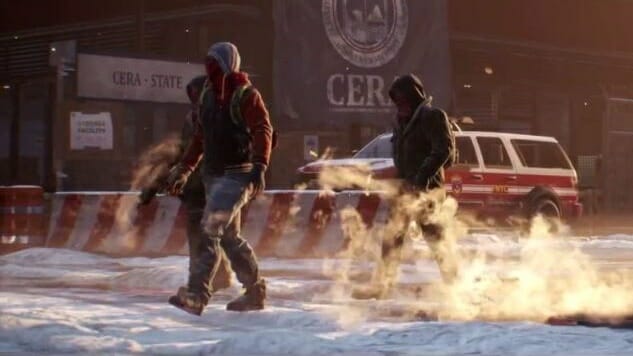The Dissonance of The Division: From Saviors to Murderers

The world of The Division is one not too unlike our own. The game is grounded in realistic roots, portraying a version of Manhattan in ruins after a highly weaponized virus has been unleashed on the populace. As factions vie for control in the chaos, you are sent in as an agent of the titular Division, to restore order and safety to New York. The realities of this situation, however, might be more dangerously real than you would expect.
In my time with The Division, I have encountered a number of enemies, ranging from the arson-prone Cleaners to the deluded Rikers. For each mission, it seemed like Ubisoft went out of its way to remind me of their criminal activity. Videos of people being burned alive, tortured, mutilated—The Division doesn’t ever stop reminding you how heroic you are in stopping these evil people from carrying out their deeds.
And still there’s one encounter I can’t keep my mind from going back to. It happens every time I’m in the streets, running from mission to mission or just exploring with friends. Rioters are often out in the street, picking supplies out of the pockets of a dead civilian or just walking around, carrying themselves as someone to not be messed with and warning the weak to get back inside. They all wear the same attire: hood up, bandana around their neck, baggy jeans. Non-descript, unable to identify one from another, yet a single silhouette that has taught me to raise my crosshairs and pull the trigger to avoid trouble.
The Division has conditioned me to treat these people as enemies first, and to not even consider an alternative to wiping them out en masse.
The immediate issue is with the dissonance this creates in the narrative. As an agent of the Division, your job is to restore order and rebuild society. This is reinforced right from the beginning, with radio call after radio call from Faye Lau constantly reminding you that we can still save the world no matter how bad it’s gotten.
If we’re to consider ourselves as the only remaining arm of the government, an everyday person turned embedded operative, then it would follow that the idea is to protect everyone, not just the sick and weak—or at least give an option to surrender, lay down arms and possibly help those who appear dangerous.
Instead, these Rioters are immediately aggressive. They’re labelled as enemies right off the bat, and often placed in situations where you’re encouraged to get the drop on them. Often distracted by scavenging supplies or just having a discussion on the street, they’re set in a way that urges you towards an inevitability: kill or be killed.
It might be easy to wave this off as an odd circumstance. Rioters are just another enemy in the game, another mob to mow down and pick up the shiny loot that drops from their fading bodies. The natural loop of The Division is shoot, loot, repeat, and that holds true to Rioters as much as it does Cleaners or Rikers.
But games can and should examine the broader context of their mechanics and nature, because there are very real correlations to be drawn in the “sights up, us or them” approach that The Division takes with its Rioters. In the real world we see protests every day, whether it’s against a hate-mongering presidential candidate or in defense of a child shot in the streets.
The Division encourages you to profile, to instantly distrust and even fire upon a person in the streets purely because of their clothes and appearance. The developers’ intentions are likely not as insidious as the end result, but the concept is still unsettling.
At many points, throughout the collectible bits of story you can find around the tattered bones of New York, these Rioters are humanized, given backstory and reasoning for their actions. They have families, businesses, opportunities. They care, are cared for and struggle, and often pick up the bat or pistol just to find some supplies for their family to make it to the next day alive. These are the people that make up the faceless mob, the wave after wave of desperate hooded vigilantes, believing they have to fight for every scrap.